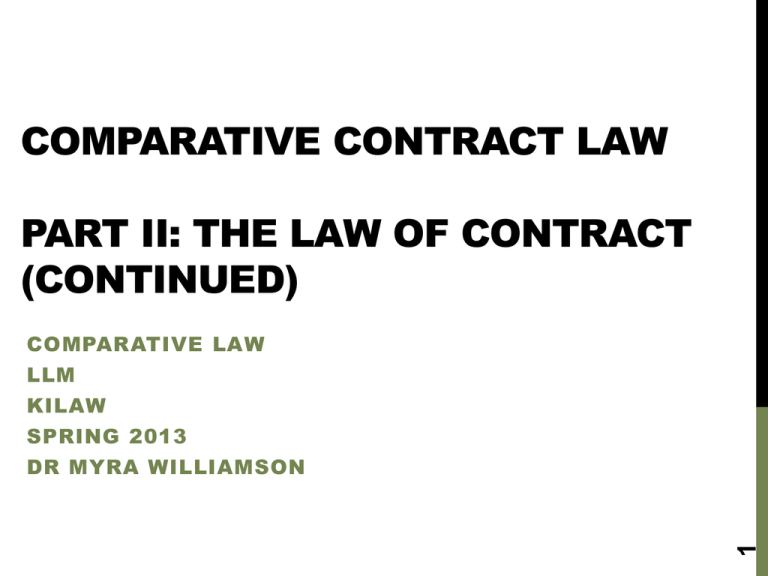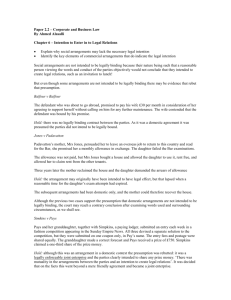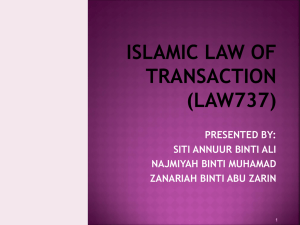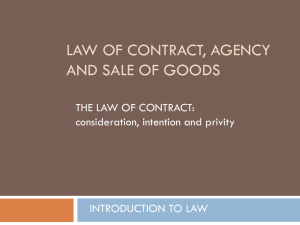Lecture 6 - Dr Myra Williamson
advertisement

COMPARATIVE CONTRACT LAW PART II: THE LAW OF CONTRACT (CONTINUED) COMPARATIVE LAW LLM KILAW SPRING 2013 1 DR MYRA WILLIAMSON THE STORY SO FAR… There are 4 main elements, all of which need to be satisfied, to form a contract in the English common law: 1. Offer and acceptance 2. They must have an intention to create legal relations/parties must intend mutual obligations 3. The parties must have the capacity to enter into the contract 4. Consideration The order is not important. Its only important that all 4 be satisfied. If any are missing, there will not be a contract. INTENTION TO CREATE LEGAL RELATIONS We have covered the first item: Offer and acceptance 3 Another element of a contract is the intention by both parties to create legal relations OVERVIEW This requirement did not exist until the 19th century It is now established that an agreement will not constitute a binding contract unless it is one which can reasonably be regarded as having been made in contemplation of legal consequences A mere statement made in the course of conversation will not constitute a binding promise – even though it has been acted upon PRESUMPTIONS: • Social and family situations are presumed NOT to give rise to legal consequences • Business and commercial situations are presumed to give rise to legal relations • In both cases, the presumption is the starting point. The presumption can be rebutted by the facts. 4 Compare with… WHERE ARE WE HEADING? 5 Three areas of interest: 1. Social Arrangements 2. Family Arrangements 3. Commercial/business arrangements 1. SOCIAL AGREEMENTS Agreements of a purely social nature do not usually give rise to a contract because there is not usually an intention to create legal relations That doesn’t mean that social agreements can’t have a monetary value – they often do! Examples: • Accepting an invitation to dinner • An agreement between friends to take part in a golf competition • An offer to share the cost of petrol on a journey* In all these types of situations, money is involved They are agreements in which one party may incur expenses because of the promise In social engagements, there is a presumption that there is no intention to create legal relations 6 BUT whether there is a contract or not turns on whether the Court would consider that legal consequences could have reasonably been contemplated by the parties 1. SOCIAL AGREEMENTS CONT’D… See this statement in the case of: Balfour v Balfour (1919) Atkin L.J.: “…there are agreements between parties which do not result in contracts within the meaning of that term in our law. The ordinary example is where two parties agree to take a walk together, or where there is an offer and an acceptance of hospitality. 7 Nobody would suggest in ordinary circumstances that those agreements result in what we know as a contract…” (emphasis added) 2. FAMILY ARRANGEMENTS Family arrangements are another area where there is likely to be no intention to create legal relations 8 Balfour v Balfour (1919) Atkin L.J.: Facts: Parties are husband and wife Husband was employed in Ceylon – both lived there. Husband and wife both returned to England on leave but wife was unable to go back to Ceylon for medical reasons. Husband promised to pay his wife an allowance of £30 a month until she rejoined him He failed to pay; she sued him 2. FAMILY ARRANGEMENTS CONTINUED… Balfour v Balfour (1919) • Held: it was not impossible for a husband and wife to enter into a contract for maintenance • But here, the husband and wife never intended the agreement to have legal consequences A similar finding was made in a New Zealand case… Fleming v Beeves [1994] 1 NZLR 385 9 A parent’s promise to pay a child an allowance whilst at university ordinarily creates only a moral obligation – no intention to be legally bound 2. FAMILY ARRANGEMENTS However, the courts will occasionally find that there is an intention to create legal relations: here is one such case… Simpkins v Pays (1955) 1 WLR 975 The facts: Simpkins was boarding in Pays’ house Pays was an 83-year-old widow There was a weekly newspaper competition Simpkins agreed with Pays and with Pays’ granddaughter to jointly enter in a weekly coupon submitted in a fashion competition The parties agreed “to go shares” if they won – that was the basis of the arrangement After about 7 or 8 weeks, Pays’ grand-daughter’s forecast was correct 10 The plaintiff – Simpkins – wanted to share in the prize SIMPKINS V PAYS (1955) CONTINUED… Held: “there was a mutuality in the arrangement between the parties. It was not very formal but…it was agreed that if there was success, no matter who won, all should share equally” The plaintiff and the defendant entered into an agreement to share Plaintiff was entitled to one-third i.e.. £250 NOTE: ‘Lotto’ cases come up from time to time. Sometimes one party sues because there was an understanding about sharing the winnings. It’s hard to prove that there was a contract. There have been some interesting cases: http://www.telegraph.co.uk/finance/personalfinance/8832648/Spouseshave-no-right-to-lottery-winnings.html 11 It’s hard to tell in advance which way the court will go. It very much turns on the individual facts of the case. PARKER V CLARK (1960) Here is another “family arrangement” case where the court went against the presumption and found that there was an intention to create legal relations The facts: • Mr and Mrs Clarke agreed that their niece (Parker) and her husband could live in their house, share the bills and then the Clarkes would leave the house to the Parkers when they died • Mrs Clark wrote to the Parkers detailing the expenses and setting out the agreement • An agreement was made whereby the Parkers would sell their house and would move in with the Clarkes – to share the household expenses • The Parkers then sold their house and moved in with the Clarks (the Clarks also changed their will to leave the house to the niece on death) • BUT then there was a falling out and the Parkers were asked to leave 12 What do you think the court found? Was there an intention to create legal relations? This is a family situation – so the starting point is the presumption against legal relations PARKER V CLARK (1960) CONTINUED… Held: the exchange of letters showed that both couples were serious about this arrangement They intended it to be legally binding because: 1) The Parkers sold their own home; and 2) Mr Clarke changed his will so that the house would be left to the Parkers. 13 The court held that, even though it was a family arrangement, here there was a contract; the parties did intend to create legal relations so the Parkers were entitled to damages for breach of contract 2. FAMILY ARRANGEMENTS SUMMARISED 14 Generally, agreements between husbands and wives and between parents and children are presumed not to be enforceable contracts The Presumption: no intention to create legal relations Sometimes the court upholds the presumption (see Balfour v Balfour and Fleming v Beeves) and other times they go against the presumption and find that the parties did intend their agreement to have legal consequences (see Simpkins v Pays and Parker v Clark) It will depend on the facts 3. COMMERCIAL /BUSINESS ARRANGEMENTS In commercial arrangements, the law starts from the opposite point of view – it is presumed that the parties intend their agreements to have legal consequences This presumption may be negated by express terms – there has to be strong evidence that there was no intention to create legal relations 15 At least three cases which are authority for this proposition, we will look at them in turn… 3. COMMERCIAL /BUSINESS ARRANGEMENTS 16 Rose v Crompton Bros (1925) The facts: Defendants were paper manufacturers Plaintiffs were to act as sole agents for the defendants in the US The parties entered into a written agreement which contained a clause that stated: “This arrangement is not, nor is this memorandum written, as a formal or legal agreement and shall not be subject to legal jurisdiction in the law courts.” ROSE V CROMPTON BROS (1925) CONTINUED… The parties wrote that they would carry out the agreement with “mutual loyalty” and “friendly co-operation” The “Honourable Pledge Clause” Plaintiffs placed orders for paper; Defendants accepted the orders; 17 Before the paper was sent, the defendants terminated the agreement and refused to send the paper ROSE V CROMPTON BROS (1925) CONTINUED… 18 Held: The agency agreement was not legally binding The court said it would respect the intention on the parties upon entering into the contract* They agreed to enter it on the basis of “mutual loyalty” and “friendly co-operation” [However, note that with respect to the orders that had been placed and accepted, the court found that there had been contracts created and the defendants were in breach of contract for failing to fill them] JONES V VERNON’S POOLS LTD (1939) Facts: The plaintiff (Jones) tried to claim football pools winnings (football betting) but the coupon had the words “Binding in honour only” printed on it Held: These words were sufficient evidence to rebut the presumption of an intention to create a legal relationship Similar case: Appleson v Littlewood (1939) Facts: Appleson sent in a football pools coupon It had the words “it shall not be attended by or give rise to any legal relationship, rights, duties, consequences” Held: Plaintiff could not recover 19 There was no intention to create legal relations SUMMARY ON COMMERCIAL/BUSINESS ARRANGEMENTS Court presumes that there IS an intention to create legal relations But this can be rebutted However, clear evidence is needed - an express term is usually required If a reasonable person would consider that there was an intention to create a contract, then the court will find the parties to have been bound 20 The test of whether there was an intention to create legal relations is an objective test END OF THIS ELEMENT Remember the differences between social and family arrangements v business arrangements A different presumption applies 21 It will often turn on the facts as to whether the presumption can be rebutted











